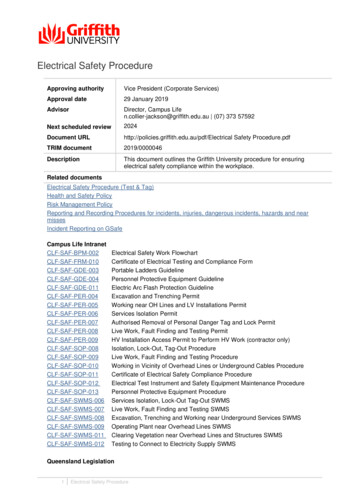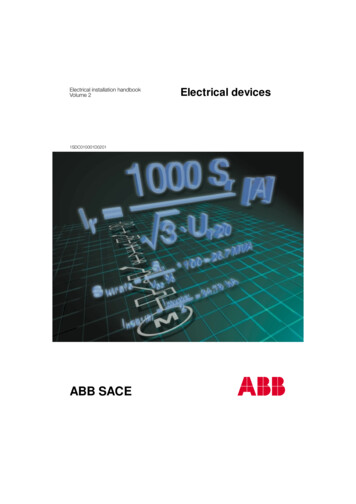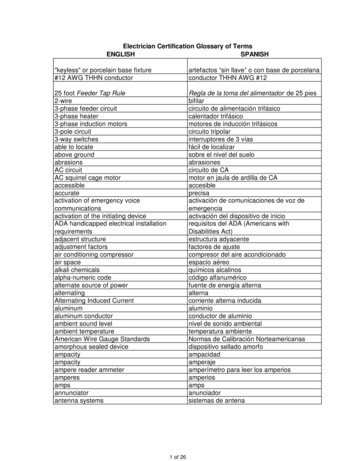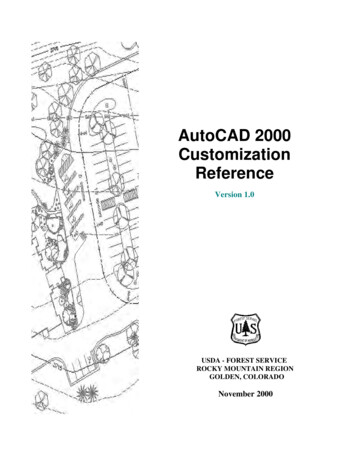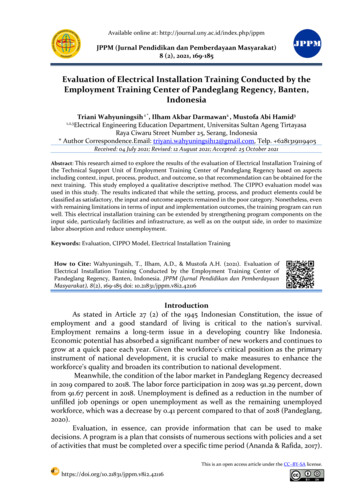
Transcription
Available online at: http://journal.uny.ac.id/index.php/jppmJPPM (Jurnal Pendidikan dan Pemberdayaan Masyarakat)8 (2), 2021, 169-185Evaluation of Electrical Installation Training Conducted by theEmployment Training Center of Pandeglang Regency, Banten,IndonesiaTriani Wahyuningsih 1 *, Ilham Akbar Darmawan2 , Mustofa Abi Hamid31,2,3Electrical Engineering Education Department, Universitas Sultan Ageng TirtayasaRaya Ciwaru Street Number 25, Serang, Indonesia* Author Correspondence.Email: triyani.wahyuningsih12@gmail.com, Telp. 6281319119405Received: 04 July 2021; Revised: 12 August 2021; Accepted: 25 October 2021Abstract: This research aimed to explore the results of the evaluation of Electrical Installation Training ofthe Technical Support Unit of Employment Training Center of Pandeglang Regency based on aspectsincluding context, input, process, product, and outcome, so that recommendation can be obtained for thenext training. This study employed a qualitative descriptive method. The CIPPO evaluation model wasused in this study. The results indicated that while the setting, process, and product elements could beclassified as satisfactory, the input and outcome aspects remained in the poor category. Nonetheless, evenwith remaining limitations in terms of input and implementation outcomes, the training program can runwell. This electrical installation training can be extended by strengthening program components on theinput side, particularly facilities and infrastructure, as well as on the output side, in order to maximizelabor absorption and reduce unemployment.Keywords: Evaluation, CIPPO Model, Electrical Installation TrainingHow to Cite: Wahyuningsih, T., Ilham, A.D., & Mustofa A.H. (2021). Evaluation ofElectrical Installation Training Conducted by the Employment Training Center ofPandeglang Regency, Banten, Indonesia. JPPM (Jurnal Pendidikan dan PemberdayaanMasyarakat), 8(2), 169-185 doi: 10.21831/jppm.v8i2.42116IntroductionAs stated in Article 27 (2) of the 1945 Indonesian Constitution, the issue ofemployment and a good standard of living is critical to the nation's survival.Employment remains a long-term issue in a developing country like Indonesia.Economic potential has absorbed a significant number of new workers and continues togrow at a quick pace each year. Given the workforce's critical position as the primaryinstrument of national development, it is crucial to make measures to enhance theworkforce's quality and broaden its contribution to national development.Meanwhile, the condition of the labor market in Pandeglang Regency decreasedin 2019 compared to 2018. The labor force participation in 2019 was 91.29 percent, downfrom 91.67 percent in 2018. Unemployment is defined as a reduction in the number ofunfilled job openings or open unemployment as well as the remaining unemployedworkforce, which was a decrease by 0.41 percent compared to that of 2018 (Pandeglang,2020).Evaluation, in essence, can provide information that can be used to makedecisions. A program is a plan that consists of numerous sections with policies and a setof activities that must be completed over a specific time period (Ananda & Rafida, 2017).This is an open access article under the CC–BY-SA license.https://doi.org/10.21831/jppm.v8i2.42116
JPPM (Jurnal Pendidikan dan Pemberdayaan Masyarakat), 8 (2), 2021 - 170Triani Wahyuningsih , Ilham Akbar Darmawan, Mustofa Abi HamidThis evaluation is useful in determining if a program should be continued, altered, orterminated. The evaluation will also assess the success of each program that has beenexecuted (Munthe, 2015). Meanwhile, Darojat and Wahyudiana (2015) state thatevaluation is used to determine the level of program success, and that decision is thenused to determine whether the program is continued, postponed, enhanced, developed,accepted, or rejected.A program evaluation is a set of activities carried out deliberately and meticulouslyto establish the level of implementation or success of a program (Setiyaningrum, 2016).The assessment procedure necessitates the usage of an evaluation model, and the CIPPOmodel is a modification produced by Gilbert Sax from the evaluation of the StufflebeamCIPP model program. The CIPPO program evaluation model is made up of fiveassessment aspects: context, input, process, product, and outcome, all of which areimportant in evaluating the program as a whole. Meanwhile, the CIPP programevaluation simply looks at the product and does not consider the program's impact. Anoutcome evaluation (Susilawati et al., 2016) is included in this study, which assesseswhether participants who have completed the program are able to secure jobs, namelythe competence of training participants from competency-based training programs inthe commercial and industrial sector.Because it contains both a formal and a complete assessment, the CIPPassessment model is a more comprehensive assessment model. Context, input, process,and product evaluation can be performed in the context of decision making (priorcondition) and information presentation related to responsibilities (integrated role)(Mahmudi, 2011). The Employment Training Center is a facility where trainees can learnand master a specific type and level of work competence in order to enter major labormarkets and/or independent firms, as well as a place for training to raise workproductivity in order to improve welfare (Permenaker, 2017).The Employment Training Center, as a vocational education institution, requiresmore attention in order for its management to function optimally. Vocational educationis built on three pillars: meeting the desires of people who want to work, expandingeducational options, and giving high motivation to enhance various forms of learning(Darmawan et al., 2019). The Center is more than just a place to create skilled output; italso makes it simpler to work and be an entrepreneur, thus it is envisaged that theCenter’s activities will eventually reduce the rate of unemployment (Daud, 2019).There are various parts in the CIPPO evaluation paradigm, including context,input, process, product, and result. In these areas, components such as the curriculum,facilities and infrastructure, training management, human resources such as teachersand training participants, and other committees are examined. The curriculum is alearning guide that includes materials and training learning strategies. In general,facilities and infrastructure are instruments and equipment that aid in the learningprocess when performing public services in order to fulfill educational goals. The aimsand learning process will not be attained adequately if the facilities and infrastructureare not appropriately provided.MethodThis research employed a form of evaluation that is program evaluation. In thisstudy, the curriculum for the electrical installation training was evaluated. This was anevaluation study carried out at the Pandeglang Employment Training Center. TheCopyright 2021, JPPM, ISSN 2355-1615 (print), ISSN 2477-2992 (online)
JPPM (Jurnal Pendidikan dan Pemberdayaan Masyarakat), 8 (2), 2021 - 171Triani Wahyuningsih , Ilham Akbar Darmawan, Mustofa Abi Hamidresearch subjects for this study were training participants, training instructors, theorganizing committee, and the head of the Employment Training Center of PandeglangRegency. The assessment model employed was CIPPO (Context, Input, Process,Product, Outcome), which is a revision of Stufflebeam's CIPP model. The CIPP modelonly measures the product or the results of the training, whereas the CIPPO gives anevaluation of the results' implementation, which is to determine how the graduates areperforming in the community or in their further education. The research data werecollected at the Employment Training Center of Pandeglang Regency. This study wasconducted from early June 2021 until July 2021. This study also employed an expost pactoresearch design for data frim 2020. The chairman, one organizing committee, oneelectrical installation training instructor, and one electrical installation trainingparticipant in 2020 were the sources of data in this research.The organizers of the training program and participants in the electricalinstallation training program were the subjects of this study. Respondents in this studyincluded the Pandeglang Regency Training Center's Head, Pandeglang Regency TrainingCenter organizers/managers, electrical installation training instructors, and electricalinstallation training participants. The objective of this study was to develop an electricalinstallation training program at the Pandeglang training center that includes context,input, input, process, results, and feedback. This evaluation study used observation,interviews, and documentation studies to acquire data. Data on the existing facilitiesand infrastructure of the Pandeglang job training center were gathered throughobservations. Appropriate observation procedures, such as systematic observation andrecording of the events being observed, were utilized to examine the availability ofsupporting facilities and equipment (Redy et al., 2018). (Mania, 2008). Observationswere made through monitoring a number of actions during the education and trainingprogram's evaluation process (Aryanti et al., 2015). This observation technique yieldednarrative information and documentation of input in the form of facilities andinfrastructure at the Pandeglang job training center. In addition, interviews were alsoconducted, which comprised of conversation between two or more persons, withquestions typically asked by someone acting as an interviewer with a specific aim (Salim& Sahrum, 2012). The interview approach employed was a structured interview methodwith interview guidelines, but it does not rule out the potential of further questions ifthe informant offered additional information. This interviews were done to gatherinformation about the setting, input, training procedure, training results, and outcomes(reciprocity). The data derived from the interviews were the informants' presentationson the features being evaluated by answering several questions provided by theresearchers. Documentation studies were also performed to gather information for thisresearch in the form of supporting materials. These documents were used to learn moreabout the context aspect, input aspect, aspect, process aspect, and outcome aspect.Documents collected also included a list of names of training participants, instructors’data, a list of organizing committees, a list of participants and instructors attending,training schedules, and others. The documents were then described by the researchers.Triangulation was used in this research. Triangulation in data collection is aprocedure for collecting data and data sources that combines several data collectiontechniques and existing data sources (Sugiono, 2018). To justify the outcomes of theirevaluation work, qualitative evaluators are frequently required to follow a systematic setof processes and means. As a result, they frequently employ triangulation processesCopyright 2021, JPPM, ISSN 2355-1615 (print), ISSN 2477-2992 (online)
JPPM (Jurnal Pendidikan dan Pemberdayaan Masyarakat), 8 (2), 2021 - 172Triani Wahyuningsih , Ilham Akbar Darmawan, Mustofa Abi Hamid(Amin, 2014). According to the data or information required, data collected were resultsof observations, interviews, and documentation, which were then analyzed using aqualitative descriptive analysis technique, which consists of three components: datareduction, data display, and drawing conclusions (Sudijono, 2011). The resulting datawere then collected and reduced or sorted based on needs. In addition, the reduced datawere then presented in a descriptive format. Following the data display, conclusionswere taken from each data set obtained. Triangulation was employed to determine thevalidity of the data in this study, which included source triangulation, timetriangulation, and data collecting procedures triangulation. The researchers were ableto confirm the validity of the data by employing the triangulation technique. Successcriteria were required to determine the outcomes of each evaluation performed.Meanwhile, the success criteria for the evaluation of the electrical installation trainingprogram were based on the rules provided by the institution authorized, as the Ministryof Manpower has specific regulations in place addressing the Employment TrainingCenters and the implementation of Competency-Based Training.Result and DiscussionThis evaluation research included aspects namely context, input, process, productand outcome.Context EvaluationAccording to Sax G. (in Widoyoko, 2017), context evaluation is a description andspecification of the environment of the program to be implemented as well as unfulfilleddemands. The purpose of analyzing the context is to analyze if the training program'sobjectives have been correctly designed, based on the results of the instructional analysisand taking into account the existence of policies (Prastati, 2011). Context evaluationseeks to assess the whole state of the item by identifying flaws and strengths, diagnosingproblems and proposing solutions, and determining whether goals and priorities areappropriate for the needs to be achieved (Tulung, 2014). The findings of the research onthe context include: the legal basis employed, the aims, duties, and functions of theemployment training center, the relevance of the community's requirements with thetraining held, and indicators of the program's effectiveness.Legal Bases for Employment TrainingThe legal basis for training in employment training centers is Article 9 No. 13 ofthe Indonesian Manpower Act of 2003, which outlines job training. The establishmentof the Pandeglang Job Training Office Technical Implementation Unit is regulated underPandeglang Regency Regent Regulation Number 45 of 2018. The vocational trainingcenters were formerly under the authority of the central government, however, theauthority has been delegated to the regions, which is regulated in IndonesianGovernment Regulation number 38 of 2007 concerning the Division of GovernmentAffairs between the Central Government, Provincial Governments, and Regency/CityRegional Governments, as well as in Regulation of the Minister of Home Affairs ofIndonesia Number 12. As the organizer and organizer of the training program, thePandeglang Job Training Center refers to Government Regulation No. 31 of 2006 on theIndonesian National Training System.A successful training implementation program must have a legal foundation orinstructions for training implementation in the form of legislation or ministerial rules.Copyright 2021, JPPM, ISSN 2355-1615 (print), ISSN 2477-2992 (online)
JPPM (Jurnal Pendidikan dan Pemberdayaan Masyarakat), 8 (2), 2021 - 173Triani Wahyuningsih , Ilham Akbar Darmawan, Mustofa Abi HamidA successful program is one that has been thoroughly prepared and has a solidfoundation for implementation. The legal basis for the electrical equipment trainingprogram at the Pandeglang’s employment training center has been thoroughly evaluatedand complies with all requirements for conducting an electrical installation trainingprogram, as it already has a sound and clear foundation, namely the program's legalbasis.Duties and Function of the Employment Training Center of Pandeglang RegencyThe Employment Training Center's primary responsibility is to organize job skillstraining for job seekers, workers, and other community members in need of training andcertification. The Employment Training Center's mission is to develop skilled,disciplined, productive, polite, and devout workers for God Almighty, as well as toperform other official duties as assigned. According to the study's findings, thisvocational training institution performed admirably in this additional responsibility.However, because there are no specific regulations or affirmations governing thePandeglang Job Training Center's tasks and functions, this duty is carried out in light ofthe Employment Training Center's general duties.Needs Analysis for the Electrical Installation TrainingThe purpose of a workplace needs analysis is to ascertain the most criticaltraining requirements (Irianto, 2001). Information on these demands will enablebusinesses to make the most use of their resources (time, money, etc.) while eliminatingsuperfluous training initiatives. According to the research findings, identifying thetraining program for need assessment or community needs for electrical installationtraining at the Pandeglang’s Employment Training Center is limited to the packagereceived from the central government, and the Center provides comprehensive electricalinstallation training. This is purely based on the fact that Banten is densely populatedwith companies and that residents of Pandeglang can enter the industrial sector throughelectrical installation training. The electrical installation preparation program'simplementation can be viewed as not satisfying the needs of the Pandeglang community.Similarly, the electrical installation preparation program at the Pandeglang EmploymentTraining Center is not being implemented in accordance with the established processfor identifying community needs (Ministry of Manpower of the Republic of Indonesia,2014).The Objectives of the Electrical Installation TrainingAccording to the findings of the research, the electrical installation trainingprogram at the Pandeglang Employment Training Center has been implemented for thepurpose of providing Industrial and Agricultural Training through Competency-BasedTraining, Community-Based Training, and Mobile Job Training. The Center's ElectricalInstallation Training Program has a well-defined training aim, adheres to a highstandard of implementation, and is generally satisfactory. A good and clear goal willgenerate a favorable view from the community and will be regarded positively by thecommunity. The Pandeglang employment training center has accomplished its objectivewell.Copyright 2021, JPPM, ISSN 2355-1615 (print), ISSN 2477-2992 (online)
JPPM (Jurnal Pendidikan dan Pemberdayaan Masyarakat), 8 (2), 2021 - 174Triani Wahyuningsih , Ilham Akbar Darmawan, Mustofa Abi HamidSuccess Indicators for the Electrical Installation Training ProgramA program is continually seeking success, and in order to determine if theprogram has been effective or not, an indicator of program success is created. Accordingto the research findings, the electrical installation training program at the EmploymentTraining Center of Pandeglang has indicators of program success, namely successfulcompletion of programs by participants, demonstration of high levels of competence,and preparedness to compete in the labor market. According to the data on the trainingprogram's success indicators, the electrical installation training program's execution atthe Center can be judged to have had extremely clear and positive signs of programsuccess. Thus, the presence of these indicators can serve as a barometer for theprogram's effectiveness at the Employment Training Center of Pandeglang.Input EvaluationInput evaluation provides data that can be utilized to evaluate the most effectiveuse of resources to accomplish program objectives. Additionally, input can be referredto as preparation prior to the start of a training program (Eriza Nugrahvianti Fadilah,2014). Meanwhile, the input evaluation components include the following: a) HumanResources, b) Facilities and infrastructure, as well as supporting equipment, c)Funds/budget, and d) Various procedures and rules that may be required. Additionally,the input evaluation examines the readiness of training participants, instructors,organizers, materials, and training facilities and infrastructure (Adhim & Wiyono, 2015).This input can be evaluated on a variety of levels, including human resource readiness(organization committee, participants, instructors), budget, and existing facilities andinfrastructure.Human ResourcesHuman resources is a critical factor in determining the success of a program.These human resources include the organizing committee's readiness, the instructor'sreadiness, and the training participants' readiness. The organizers of the electricalinstallation training at the Pandeglang Regency Job Training Center are divided into twocommittees: the committee responsible for recruiting training participants and thecommittee responsible for organizing the training program. The following is a list of themembers of the organizing committee for the electrical installation training program.Table 1. The list of the members of recruitment committee of the Employment Training Center ofPandeglang RegencyNoNameEducationPositionsBackground1.Joko Sotejo, S.Pd Bachelorof landari A.Md Degree3.Herry Islachudin HighSchool SupportDiplomaOfficer4.Riska Dwi Cahya, BachelorInstructorSEDegreeCopyright 2021, JPPM, ISSN 2355-1615 (print), ISSN 2477-2992 (online)
JPPM (Jurnal Pendidikan dan Pemberdayaan Masyarakat), 8 (2), 2021 - 175Triani Wahyuningsih , Ilham Akbar Darmawan, Mustofa Abi HamidTable 2. The List of Organizing Committee Members of Employment Training Center ofPandeglang , S.Pd.Bachelor Degree Instructor2.SutrisnoHighSchoolDiploma3.Rizki Faturrahman, SBachelor Degree4.Jokri, STBachelor DegreeAdmin and SupportOfficer ator forHuman Resourcesand Internal AffairsInstructorWhile the implementation of this training program has been generallysatisfactory, it does have several shortcomings, including the lack of an adequatenumber of Human Resources at the Pandeglang Regency Employment Training Centerto ensure that employees can continue to fulfill their obligations concurrently. This willundoubtedly disturb these workers' centralization of labor. The electrical installationtraining program's instructors are responsible for delivering education and training inline with the program's curriculum and syllabus. At the Pandeglang RegencyEmployment Training Center, the electrical installation training program is taught bytwo instructors. The Ministry of Manpower is responsible for and regulates therecruitment of instructional personnel at the Pandeglang Regency EmploymentTraining Center.Table 3. The List of the Electrical Installation Training InstructorsNoNameEducationPositionBackground1.Budi Santoso, STBachelorInstructorDegree2.Farida Yuanita W, ST BachelorInstructorDegreeAccording to the results of observations at the Pandeglang Regency EmploymentTraining Center, the electrical installation instructors have developed an effectiveprogram, and the instructors possess adequate abilities as a result of completing theinstructor competency test. Additionally, the framework of the electrical installationtraining program meets the Employment Training Center standards outlined inMinisterial Regulation No. 8 of 2017.The electrical installation training program at the Pandeglang Regencyemployment Training Center is open to residents of the Pandeglang area who wish toparticipate in the training. They had previously registered and received an account fromthe Ministry of Manpower, and then re-registered at the registration counter, specificallyat the administrative section of the Center, after passing the recruitment committee'swritten test or interview test. Additionally, they have fulfilled the equipmentdocumentation requirements and are considered to have conformed with theprovisions. The electrical installation training program has a maximum of 16Copyright 2021, JPPM, ISSN 2355-1615 (print), ISSN 2477-2992 (online)
JPPM (Jurnal Pendidikan dan Pemberdayaan Masyarakat), 8 (2), 2021 - 176Triani Wahyuningsih , Ilham Akbar Darmawan, Mustofa Abi Hamidparticipants, and the first batch of electrical installation training program had amaximum of 16 participants who were eligible to join the program.According to the research findings, the readiness of the training participants wassatisfactory, as the trainees who wished to engage in the electrical installation traininghad already participated in a series of recruitments conducted by the committee. Then,on average, participants were people who genuinely want to work and attend training inorder to improve their abilities and access information about job openings more quickly.Facilities and InfrastructuresApart from human resources, the success of a program is determined on theCenter's facilities and infrastructure. Infrastructure refers to equipment that is employedindirectly to accomplish educational goals, such as location, school buildings, sportsfields, and money. Meanwhile, means refers to tangible equipment used to accomplisheducational objectives, such as rooms, books, libraries, and laboratories (Prastyawan,2016). Infrastructure includes numerous components of the Pandeglang districtemployment training center (Indonesia, 2017), including learning resources, practiceequipment, study and practice room amenities, as well as supporting facilities such asplaces of worship, restrooms, canteen rooms, and land parking.The electrical installation training program at the Pandeglang district job trainingcenter makes use of learning resources provided to participants in the form of learningmodules. This module is designed to supplement the theoretical instruction providedduring the electrical installation training program. Additionally, practical tools andfunctional materials are used as learning resources. Electrical installation trainingresources The learning resources of the Pandeglang district job training center areadequate and fulfill the participants' needs.According to the findings of researchers' observations and interviews, theworkshop room includes the following amenities: a) there is one workshop room thatdoubles as a theory room; b) there are twenty trainee chairs (wooden chairs); and c)availability of tables and instructor chairs that is 2 tables and 2 wooden chairs, d) onecomputer unit, e) three in good condition fans, f) one blackboard, g) one projector, h)two sound systems, i) trash can and cleaning equipment which were in good condition,j) one water dispenser, k) 16 electric lighting installation boards, l) 8 trainer panels andelectric motors, and m) 4 lighting fundamental trainers.The electrical workshop is in good condition; it is only the age of the buildingthat makes it appear shabby and insufficient. That is because the participants' seats arestill made of wood and the room is relatively small due to the use of the same room forthe practice and theory sessions. One could argue that the room's general state isinsufficient and requires complete refurbishment to ensure the trainees' comfort.Convenience in engaging in learning activities will also have an effect, and the trainingprogram's results may be less than optimal as a result of a lack of concentration. Toaccomplish this, a contribution from the local government is required to renovate thePandeglang regency employment training center to improve its facilities andinfrastructure.According to the study's findings, the supporting facilities at the work trainingfacility in Pandeglang Regency were toilets, which were still in short supply due to thepresence of only two toilets. Then there are no worship facilities such as prayer rooms,canteens, or designated parking lots, and participants and employees are forced to parkCopyright 2021, JPPM, ISSN 2355-1615 (print), ISSN 2477-2992 (online)
JPPM (Jurnal Pendidikan dan Pemberdayaan Masyarakat), 8 (2), 2021 - 177Triani Wahyuningsih , Ilham Akbar Darmawan, Mustofa Abi Hamidin undesignated locations. The room used for training is still insufficient for amultipurpose facility. The figures above indicate that the Pandeglang regencyemployment training center's supporting facilities are still severely insufficient. This alsoviolates the norms for work training facility infrastructure set forth in Minister ofManpower Regulation No. 8 of 2017.Funding for the Training ProgramAccording to researcher interviews, the training program at the Pandeglangregency employment training center, particularly the electricity installation training, isfunded by the State Revenue and Expenditure Budget. The funds are derived from thebudget plotted in the Activity Operational Guide regulated by the provincial levelemployment training agency in Serang, and are channeled through the Manpower andTransmigration Office, which then channels the funds to the Pandeglangemployment training center in accordance with the budget plotted in the ActivityOperational Guide.As a result of the explanation above, it can be concluded that this trainingprogram is funded exclusively through the State Revenue and Expenditure Budget, andthat the budget received by the Pandeglang regency employment training centercomplies with the standards outlined in the Implementation Budget List and ActivityOperational Guide. This budget already covers all training expenses, from participantsupport facilities to participant consumption, transportation replacement fees, andreport writing for the employment training center. The researcher limited their analysisto financial management and did not examine the amounts distributed due to carefulconsideration for sensitive information.Process EvaluationProcess evaluation entails gathering audit data and applying it to programimplementation. Essentially, this evaluation employs a process evaluation to determinethe effectiveness of the plan's implementation and which components requireimprovement (Widoyoko, 2017). The training program's implementation process mustbe carried out as efficiently as possible, as it is from this implementation that the trainingprogram's results are decided. Additionally, the training process begins with therecruitment of training participants, fo
Electrical Installation Training Conducted by the Employment Training Center of Pandeglang Regency, Banten, Indonesia. JPPM (Jurnal Pendidikan dan Pemberdayaan Masyarakat), 8(2), 169-185 doi: 10.21831/jppm.v8i2.42116. JPPM (Jurnal Pendidikan dan Pemberdayaan Masyarakat), 8 (2), 2021 - 170 Triani Wahyuningsih , Ilham Akbar Darmawan, Mustofa Abi .
